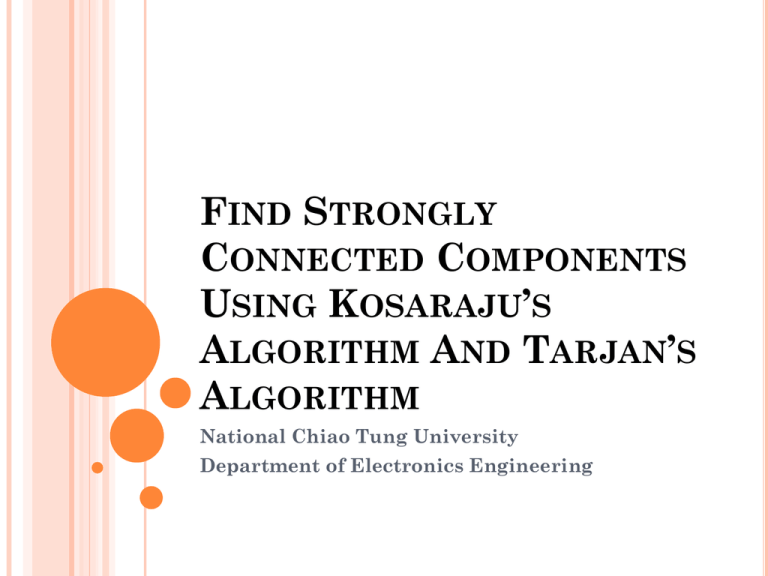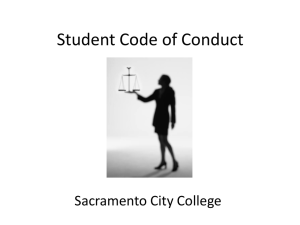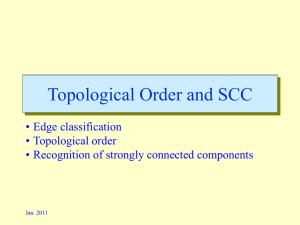SCC algorithm - WordPress.com
advertisement

FIND STRONGLY
CONNECTED COMPONENTS
USING KOSARAJU’S
ALGORITHM AND TARJAN’S
ALGORITHM
National Chiao Tung University
Department of Electronics Engineering
OUTLINE
What is strongly connected components (SCC) ?
2 properties of SCC.
How Kosaraju’s Algorithm works.
Complexity of Kosaraju’s Algorithm.
How ’s Tarjan’s Algorithm works.
Complexity of Tarjan’s Algorithm.
WHAT IS STRONGLY CONNECTED
COMPONENTS?
Definition: A strongly connected components
(SCC) of a directed graph G = (V, E) is a maximal
set of vertices C ⊆ V, such that every vertices in
C is reachable from each other.
Not strongly connected:
Strongly connected:
PROPERTY(I) OF STRONGLY CONNECTED
COMPONENTS
If we compress each SCC set in the graph G to a
single vertex, G will become a DAG.
A
B
C
E
F
G
D
CD
ABE
FG
PROPERTY(I) OF STRONGLY CONNECTED
COMPONENTS
The compressed SCC graph is a DAG.
Lemma 22.13: Let C and C’ be distinct SCCs in
directed graph G. Let u, v ∈ C; u’, v’ ∈ C’. If G
contains a path (u, u’), then G cannot also contain
a path (v’, v).
Proof:
1. If G contains both (u, u’) and (v’, v), then C and
C’ is reachable from each other.
2. Because vertices in a SCC set is reachable from
each other, every vertex in C and C’ will be
reachable from each other.
3. Thus, C and C’ are not distinct SCC =>
contradiction.
PROPERTY(II) OF STRONGLY CONNECTED
COMPONENTS
Graph G and its transpose GT have exactly the
same SCCs.
A
B
C
D
E
A
E
B
C
D
PROPERTY(II) OF STRONGLY CONNECTED
COMPONENTS
Informal proof.
A SCC set → vertices within it construct a cycle.
Reverse the edges of a cycle → still a cycle.
According to property I, we can transform graph
G in to a DAG.
Reverse the edges of a DAG → still a DAG.
So the SCC sets of G is the same as GT ’s.
KOSARAJU’S ALGORITHM
Make use of the second property of SCC.
Kosaraju(G)
1. Run DFS(G) to compute finishing times u.f for
each vertex u.
2. Compute GT.
3. Run DFS(GT), choose the vertices with the
decreasing order of u.f calculated in step 1.
4. Put every vertex visited during each DFS
iteration into current SCC set.
5. When current DFS iteration comes to an end,
put current SCC set into SCC list, and start next
DFS iteration from another unvisited vertex.
6. After all vertices are visited, we get a complete
SCC list.
KOSARAJU’S ALGORITHM
Run DFS(G).
A
B
C
D
13/14
11/16
1/10
8/9
12/15
3/4
2/7
5/6
E
F
G
H
KOSARAJU’S ALGORITHM
Compute GT.
A
B
C
D
13/14
11/16
1/10
8/9
12/15
3/4
2/7
5/6
E
F
G
H
KOSARAJU’S ALGORITHM
Run DFS(GT).
Start from B
Present SCC set: {B}
Present SCC list: NULL
A
B
C
D
13/14
11/16
1/10
8/9
12/15
3/4
2/7
5/6
E
F
G
H
KOSARAJU’S ALGORITHM
Run DFS(GT).
Present SCC set: {B, A}
Present SCC list: NULL
A
B
C
D
13/14
11/16
1/10
8/9
12/15
3/4
2/7
5/6
E
F
G
H
KOSARAJU’S ALGORITHM
Run DFS(GT).
Present SCC set: {B, A, E}
Present SCC list: {B, A, E}
A
B
C
D
13/14
11/16
1/10
8/9
12/15
3/4
2/7
5/6
E
F
G
H
KOSARAJU’S ALGORITHM
Run DFS(GT).
Choose C.
Present SCC set: {C}
Present SCC list: {B, A, E}
A
B
C
D
13/14
11/16
1/10
8/9
12/15
3/4
2/7
5/6
E
F
G
H
KOSARAJU’S ALGORITHM
Run DFS(GT).
Present SCC set: {C, D}
Present SCC list: {B, A, E}, {C, D}
A
B
C
D
13/14
11/16
1/10
8/9
12/15
3/4
2/7
5/6
E
F
G
H
KOSARAJU’S ALGORITHM
Run DFS(GT).
Choose G.
Present SCC set: {G}
Present SCC list: {B, A, E}, {C, D}
A
B
C
D
13/14
11/16
1/10
8/9
12/15
3/4
2/7
5/6
E
F
G
H
KOSARAJU’S ALGORITHM
Run DFS(GT).
Present SCC set: {G, F}
Present SCC list: {B, A, E}, {C, D}, {G, F}
A
B
C
D
13/14
11/16
1/10
8/9
12/15
3/4
2/7
5/6
E
F
G
H
KOSARAJU’S ALGORITHM
Run DFS(GT).
Finish.
Present SCC set: {H}
Present SCC list: {B, A, E}, {C, D}, {G, F}, {H}
A
B
C
D
13/14
11/16
1/10
8/9
12/15
3/4
2/7
5/6
E
F
G
H
WHY KOSARAJU’S ALGORITHM WORKS?
According to Corollary 22.15: Each edge in the
transpose of G that goes between different SCC
goes from a vertex with an earlier finishing
time to one with a later finishing time.
According to property I, we can compress the
graph into a DAG.
So, if we choose the vertex in the transpose of G
to start DFS in the order of decreasing finishing
time, we are actually visiting the DAG of SCC in
the reverse topological order.
WHY KOSARAJU’S ALGORITHM WORKS?
Because there is a two-way path between any
pair of vertices in a SCC.
We can traverse all the vertices in a SCC by DFS
in any order.
Because we visit the DAG of SCC in the reverse
topological order.
No matter how we traverse all vertices within a
SCC by DFS, we won’t accidentally go into other
SCC. The vertices we can visit by one time of
DFS are constrained to the same SCC set.
Remember to delete the whole SCC set from the
graph once it is visited.
COMPLEXITY OF KOSARAJU’S ALGORITHM
DFS x 2, G transpose x 1
Analysis:
1. Do DFS(G) first time. => Θ(V+E) / Θ(V^2)
2. Transpose G. => Θ(E) / 0
3. Do DFS(GT) and produce SCC sets. => Θ(V+E) /
Θ(V^2)
Using adjacency list: Θ(V+E)
Using adjacency matrix: Θ(V^2)
TARJAN’S ALGORITHM
Modified DFS.
Every vertex in the SCC can be the root.
Traverse every vertex, if a vertex v is unvisited,
then it is the root of a new SCC. We call the
funciton Tarjan(v).
One time of DFS may produce multiple SCC sets.
Some parameters:
1. v.index is the time stamp we discover vertex v;
v.low is the index of oldest ancestor v can reach.
1/1
2/2
3/2
4/2
TARJAN’S ALGORITHM
1.
2.
3.
4.
Tarjan(v)
Set both v.index, v.low to a global variable “t”.
++t
Push v into the stack S.
Traverse every vertex directly reachable from v.
If vertex w is unvisited, run Tarjan(w). Then set
v.low = min{v.low, w.low}.
b. If vertex w is visited, v.low = min{v.low, w.low}
a.
5.
6.
7.
8.
After the loop above, we can get the index of the
oldest ancestor reachable from v (a.k.a. v.low).
If (v.low == v.index), v is the root of the SCC.
Pop the items in stack out until v is popped out.
Those vertices compose a SCC.
TARJAN’S ALGORITHM
A
SCC list: NULL
B
C
Stack
E
D
F
G
TARJAN’S ALGORITHM
1/1
A
SCC list: NULL
B
C
A
Discover A, put A in the stack.
Stack
E
D
F
G
TARJAN’S ALGORITHM
1/1
A
2/2
B
SCC list: NULL
B
C
Discover B, put B in the stack.
A
Stack
E
D
F
G
TARJAN’S ALGORITHM
1/1
A
2/1
A is a visited
ancestor, so
B we change
B.low to 1
SCC list: NULL
B
C
A
Stack
E
D
F
G
TARJAN’S ALGORITHM
1/1
A
2/1
B
SCC list: NULL
C
Discover C, put C in the stack.
B
3/3
C
A
Stack
E
D
F
G
TARJAN’S ALGORITHM
1/1
A
2/1
B
SCC list: NULL
D
Discover D, put D in the stack.
C
B
3/3
C
A
Stack
E
4/4
D
F
G
TARJAN’S ALGORITHM
1/1
2/1
3/1
A
B is a visited
B ancestor, so
we change
D.low to 1.
Then trace
back one level
C and change
C.low to 1.
SCC list: NULL
D
C
B
A
Stack
E
4/1
D
F
G
TARJAN’S ALGORITHM
1/1
A
2/1
B
SCC list: NULL
E
Discover E, put E in the stack.
D
C
B
3/1
C
A
Stack
E
4/1
D
5/5
F
G
TARJAN’S ALGORITHM
1/1
A
SCC list: NULL
F
2/1
Discover F, put F in the stack.
E
B
D
C
B
3/1
4/1
C
A
Stack
D
E
F
5/5
6/6
G
TARJAN’S ALGORITHM
1/1
A
SCC list: NULL
F
2/1
E
B
D
C
B
3/1
4/1
C
A
Stack
D
E is a visited ancestor, so we change
F.low to 5.
E
F
5/5
6/5
G
TARJAN’S ALGORITHM
1/1
A
SCC list: NULL
G
Discover G, put G in the stack.
F
2/1
E
B
D
C
B
3/1
4/1
C
A
Stack
D
E
F
G
5/5
6/5
7/7
TARJAN’S ALGORITHM
1/1
A
SCC list: NULL
G
F
2/1
E
B
Pop items out until v.index ==
v.low.
That is, pop until the root vertex
of present SCC is popped out.
D
C
B
3/1
4/1
C
A
Stack
D
E
F
G
5/5
6/5
7/7
TARJAN’S ALGORITHM
1/1
A
SCC list: {G}
G
F
2/1
Pop until G. (7==7)
We got a SCC set: {G}
E
B
D
C
B
3/1
4/1
C
A
Stack
D
E
F
G
5/5
6/5
7/7
TARJAN’S ALGORITHM
1/1
A
SCC list: {G}, {E, F}
F
2/1
E
B
Pop until E. (5==5)
We got a SCC set: {E, F}
D
C
B
3/1
4/1
C
A
Stack
D
E
F
G
5/5
6/5
7/7
TARJAN’S ALGORITHM
1/1
A
2/1
B
SCC list: {G}, {E, F}, {A, B, C, D}
D
C
B
3/1
4/1
C
Pop until A. (1==1)
We got a SCC set: {A, B, C, D}
A
Stack
D
E
F
G
5/5
6/5
7/7
COMPLEXITY OF TARJAN’S ALGORITHM
Total operation: DFS x 1
Analysis:
1. Discover every vertex and initialize v.index,
v.low. => Θ(V)
2. Traverse every edge. => Θ(E) / Θ(V^2)
3. Pop items out and build SCC sets. => Θ(V)
Using adjacency list: Θ(V+E)
Using adjacency matrix: Θ(V^2)






